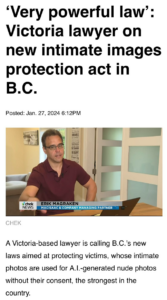The law is split on whether a litigant can be forced to sign a consent form when attending a court ordered medico-legal appointment. Today reasons for judgement were published providing further judicial commentary on the topic finding such an order is permissible.
In today’s case (Wee v. Fowler) the Plaintiff was involved in a vehicle collision and sued for damages. In the course of the lawsuit an order was made that the Plaintiff attend a defence medical exam. When the Plaintiff attended the doctor required a consent form to be signed. The Plaintiff refused and the exam did not take place.
The Defendant obtained a new order requiring attendance and signing the form. In making this order Madam Justice Harris provided the following reasons:
[37] The only remaining issue is whether the form of consent which Dr. Hirsch proposed is reasonable. While it is not strictly necessary for me to address this issue in light of my conclusions above, in the circumstances of this case, I consider it appropriate to do so.
[38] The plaintiff objects to the form on the basis that:
i. it requires the plaintiff to agree that Dr. Hirsch is independent of the parties;
ii. that she is not in a doctor/patient relationship with him;
iii. that she received an explanation as to the nature of the assessment; and
iv. that she was there voluntarily or pursuant to a court order arising from Rule 7‑6(1).
[39] The form of consent proposed by Dr. Hirsch was as follows:
Consent to Independent Medical Examination
I, ________________, date of birth ___________________ consent to participate in an independent medical examination (“IME”) conducted by Dr. Gabriel Hirsch. I am participating in the IME voluntarily or pursuant to Court Order arising from Rule 7-6(1) of the British Columbia Supreme Court Civil Rules.
I understand that Dr. Hirsh is not my treating physician and that no doctor/patient relationship arises from the IME. I also understand that Dr. Hirsch is independent of the parties involved in this matter and is not an employee of the party requesting the IME.
I acknowledge that I have received an explanation as to the nature of the assessment that will be undertaken in the IME and I authorize Dr. Hirsch to perform an assessment that includes a medical history, physical examination, review of medical imaging, tests, medical records, reports, and/or employment and school records related to my condition.
I understand that the assessment may be terminated if Dr. Hirsch determines that it is in the interest of my health and safety. I understand that I may choose to stop the assessment at any time.
I acknowledge that subsequent to the IME and pursuant to Rule 7-6(1) of the British Columbia Supreme Court Civil Rules, Dr. Hirsch may provide a medical-legal report to the referring source for the purposes of litigation. I release Dr. Hirsch and his employees from any claims which may arise as a result of the release of the above information. I am aware that the right to distribution of the report lies with the referring source and not Dr. Hirsch.
In signing this document I consent to take participate in this IME.
Dated this _________ day of _____________, 2016.
Signature of Evaluee: _________________________
Print Name: _________________________________
Signature of Witness: _________________________
Print Name: _________________________________
[40] With respect to the plaintiff’s first objection, the plaintiff suggests that Dr. Hirsch is not “independent” as he receives instructions and communicates with only one party. While it is true that Dr. Hirsch was retained by one party to the litigation, under Rule 11-2, an expert who is retained to provide an opinion, which includes physicians conducting IME’s like Dr. Hirsch, has a duty to assist the court and not be an advocate for any party. Dr. Hirsch is, therefore, to perform a role that is truly independent of the parties to the litigation. In that regard, I note that both parties refer to Dr. Hirsch conducting an “independent medical examination” in their correspondence, which is reflective of the generally accepted role of physicians conducting such examinations. I do not accept that the reference in the consent form to Dr. Hirsch being independent or to his conducting an independent medical examination to be unreasonable.
[41] The plaintiff also objects to the requirement that the plaintiff confirm her understanding that there is no doctor‑patient relationship arising from the IME. In my view, the statement, read in its context, elucidates its meaning, that is, Dr. Hirsch, although conducting a medical assessment, is not her treating physician. I am not prepared to find, without any evidence, that this statement is ambiguous or outside the knowledge of the plaintiff who, I note from the materials included in the Application Record, is a registered nurse working in a hospital setting. In any event, this is a matter which the plaintiff could ask of Dr. Hirsch should she need any clarification.
[42] The third objection is that the plaintiff is asked to confirm in advance that she has received an explanation as to the nature of the assessment. Again, I do not have evidence that suggests Dr. Hirsch did not or would not discuss the nature of the assessment prior to commencing the IME or prior to asking the plaintiff to complete the consent form. I find no basis for this objection.
[43] The final objection to the proposed form of consent is that it requires the plaintiff to agree that her attendance is voluntary or pursuant to Rule 7-6(1). The plaintiff suggests that it is either one or the other. In my view, these are the two usual circumstances under which a party participates in an IME, and the reference is simply descriptive of the basis for the plaintiff’s participation. I do not accept there is merit to the plaintiff’s objection.
[44] Accordingly, I find that the consent form proposed by Dr. Hirsch to be reasonable.





